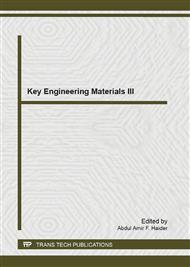p.145
p.150
p.154
p.163
p.167
p.172
p.179
p.184
p.188
Synthesis of ZnO Thin Film on Porous Silicon by Spin Coating in Various Low Molarities Precursor
Abstract:
Zinc acetate dehydrate as starting material along with diethanolamine as stabilizer, and isopropyl as a solvent were used to synthesis ZnO thin films in different low molarities. Sol-gel spin coating method was used in depositing ZnO on porous silicon substrate surface. In other to prepare substrate, p-type silicon wafer was etched by dilute hydrofluoric acid to modify the surface becomes porous. Field Emission Scanning Electron Microscopy (FESEM) was employed to study the surface morphology. It is found that ZnO thin films were successfully deposited on the substrates which are composed of ZnO nanoparticles with size ~16 nm to ~22nm. Atomic Force Microscopy (AFM) was used to investigate the surface roughness of thin film. The result shows that the surface roughness is increase as the increases of molarities. Photoluminescence (PL) spectra were done in range of 350 nm to 800 nm. The result shows peaks belonging to ZnO, ZnO defects, and porous silicon respectively are appeared.
Info:
Periodical:
Pages:
167-171
Citation:
Online since:
May 2013
Price:
Сopyright:
© 2013 Trans Tech Publications Ltd. All Rights Reserved
Share:
Citation:


